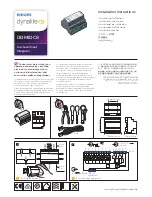
Page 6
© 2009 Active Research Limited
NMEA 0183 interfacing
The basics
NMEA data is transmitted from an information source such
as GPS, depth sounder, gyro compass etc. These data
sending devices are called “
Talkers
”.
Equipment receiving this information such as a chart-
plotter, radar or NMEA display is called a “
Listener
”.
Unfortunately, only one
Talker
can be connected on to a
single NMEA 0183 system at any one time. Two or more
“
Talkers
” are simply not possible because they are not
synchronised to each other, and will attempt to ‘talk’ at
the same time (over each other), resulting in corruption of
the NMEA data, and potentially in disaster if valuable data
such as navigation information is lost or corrupted so that
it is incorrect and/or misleading.
Actisense
produces a full range of products to solve all
NMEA interfacing requirements.
these and other
Actisense
interfacing products (NMEA
Multiplexers, NMEA Buffers, and NMEA Autoswitches),
Depth sounders and Sonar products.
The NMEA signals
The NMEA 0183 system v2.0 and later uses a ”differential”
signalling scheme, whereby two wires are used to transmit
the NMEA data. These connections will be labelled as
either NMEA “
A
” and “
B
“ or NMEA “
+
” and “
-
“ respectively,
depending on the instrument and manufacturer.
When connecting between different manufacturers, there
can be some confusion, but it is simple and easy to
remember: NMEA “
A
” connects to NMEA “
+
” and NMEA
“
B
“ connects to NMEA “
-
“.
The different NMEA standards
The NMEA 0183 specification has slowly evolved over the
years, so connecting one device to another is not always a
straightforward matter. The earlier versions of NMEA 0183
(before v2.0, as detailed above), used slightly different
connection methods and signal levels: the instruments
had just one “NMEA” data line (‘
Tx
’ or ‘
Out
’), and used
the ground as the other line - similar to the way a computer
serial port works. This connection method is referred to as
“single ended” instead of the “differential” method used by
NMEA 0183 v2.0 devices.
The data format is largely the same between both
systems, with v2.0 adding some extra sentence strings,
and removing older (redundant) sentence strings from the
specification. The situation is further complicated, as many
manufacturers still use the old (“single ended”) method of
connection because it is cheaper to implement.
The Actisense USG-1 solves all NMEA 0183 connection
issues by having inputs and outputs that are totally
compliant with both systems and which float independently
from ground at all times.
By following the simple connection diagrams in this manual,
the user can be safe in the knowledge that as long as the
connection is secure, the data will go through as intended
and no damage will result.
Please refer to the
Connecting Personal Computer RS232 port
for example of these connection methods.
Opening the USG-1
The USG-1 comes supplied with a factory installed
connection cable with tinned solder wire ends.
Using this
cable means that you will not need to open the USG-1
case to make your connections.
If you need to use your own cable, Phoenix style connectors
are provided within the USG-1 to allow you to connect it.
To open the USG-1, remove the two screws in the base of
the USG-1, then slide off the top of the USG-1 case. The
grommets need to be slid off the top of the case in order to
access the internal connections. You will be left with the
USG-1 circuitry attached to the base of the unit and the
two supplied cables attached to their connectors.
Note: When opening the USG-1 case, be aware that the
circuitry inside is not 100% protected against static
electricity. Please ensure that, when opening the case,
you use precautions against static damage - by only
touching the connector block and by holding the unit
by its base. In this way, the risks of static damage will
be minimised.
Summary of Contents for USG-1-B-422
Page 2: ......


































